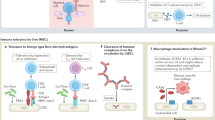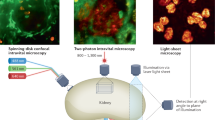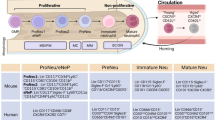Abstract
Characterization of the cellular participants in tissue immune responses is crucial to understanding infection, cancer, autoimmunity, allergy, graft rejection and other immunological processes. Previous reports indicate that leukocytes in lung vasculature fail to be completely removed by perfusion. Several studies suggest that intravascular staining may discriminate between tissue-localized and blood-borne cells in the mouse lung. Here we outline a protocol for the validation and use of intravascular staining to define innate and adaptive immune cells in mice. We demonstrate application of this protocol to leukocyte analyses in many tissues and we describe its use in the contexts of lymphocytic choriomeningitis virus and Mycobacterium tuberculosis infections or solid tumors. Intravascular staining and organ isolation usually takes 5–30 min per mouse, with additional time required for any subsequent leukocyte isolation, staining and analysis. In summary, this simple protocol should help enable interpretable analyses of tissue immune responses.
This is a preview of subscription content, access via your institution
Access options
Subscribe to this journal
Receive 12 print issues and online access
$259.00 per year
only $21.58 per issue
Buy this article
- Purchase on SpringerLink
- Instant access to full article PDF
Prices may be subject to local taxes which are calculated during checkout







Similar content being viewed by others
References
Andrian von, U.H. & Mackay, C.R. T-cell function and migration. Two sides of the same coin. N. Engl. J. Med. 343, 1020–1034 (2000).
Islam, S.A. & Luster, A.D. T cell homing to epithelial barriers in allergic disease. Nat. Med. 18, 705–715 (2012).
Sigmundsdottir, H. & Butcher, E.C. Environmental cues, dendritic cells and the programming of tissue-selective lymphocyte trafficking. Nat. Immunol. 9, 981–987 (2008).
Manicassamy, S. & Pulendran, B. Dendritic cell control of tolerogenic responses. Immunol. Rev. 241, 206–227 (2011).
Wynn, T.A., Chawla, A. & Pollard, J.W. Macrophage biology in development, homeostasis and disease. Nature 496, 445–455 (2013).
Lefrançois, L. & Puddington, L. Intestinal and pulmonary mucosal T cells: local heroes fight to maintain the status quo. Annu. Rev. Immunol. 24, 681–704 (2006).
Zhang, N. & Bevan, M.J. CD8+ T cells: foot soldiers of the immune system. Immunity 35, 161–168 (2011).
Sheridan, B.S. & Lefrançois, L. Regional and mucosal memory T cells. Nat. Immunol. 12, 485–491 (2011).
Mueller, S.N., Gebhardt, T., Carbone, F.R. & Heath, W.R. Memory T cell subsets, migration patterns, and tissue residence. Annu. Rev. Immunol. 31, 137–161 (2013).
Gebhardt, T., Mueller, S.N., Heath, W.R. & Carbone, F.R. Peripheral tissue surveillance and residency by memory T cells. Trends Immunol. 34, 27–32 (2013).
Guilliams, M., Lambrecht, B.N. & Hammad, H. Division of labor between lung dendritic cells and macrophages in the defense against pulmonary infections. Mucosal Immunol. 6, 464–473 (2013).
Galkina, E. et al. Preferential migration of effector CD8+ T cells into the interstitium of the normal lung. J. Clin. Invest. 115, 3473–3483 (2005).
Anderson, K.G. et al. Cutting edge: intravascular staining redefines lung CD8 T cell responses. J. Immunol. 189, 2702–2706 (2012).
Geissmann, F. et al. Intravascular immune surveillance by CXCR6+ NKT cells patrolling liver sinusoids. PLoS Biol. 3, e113 (2005).
Lee, W.-Y. et al. An intravascular immune response to Borrelia burgdorferi involves Kupffer cells and iNKT cells. Nat. Immunol. 11, 295–302 (2010).
Thomas, S.Y. et al. PLZF induces an intravascular surveillance program mediated by long-lived LFA-1-ICAM-1 interactions. J. Exp. Med. 208, 1179–1188 (2011).
Scanlon, S.T. et al. Airborne lipid antigens mobilize resident intravascular NKT cells to induce allergic airway inflammation. J. Exp. Med. 208, 2113–2124 (2011).
Carlin, L.M. et al. Nr4a1-dependent Ly6Clow monocytes monitor endothelial cells and orchestrate their disposal. Cell 153, 362–375 (2013).
Hogg, J.C. et al. Erythrocyte and polymorphonuclear cell transit time and concentration in human pulmonary capillaries. J. Appl. Physiol. 77, 1795–1800 (1994).
Segel, G.B., Cokelet, G.R. & Lichtman, M.A. The measurement of lymphocyte volume: importance of reference particle deformability and counting solution tonicity. Blood 57, 894–899 (1981).
Berlin-Rufenach, C. et al. Lymphocyte migration in lymphocyte function-associated antigen (LFA)-1-deficient mice. J. Exp. Med. 189, 1467–1478 (1999).
Cose, S., Brammer, C., Khanna, K.M., Masopust, D. & Lefrançois, L. Evidence that a significant number of naive T cells enter non-lymphoid organs as part of a normal migratory pathway. Eur. J. Immunol. 36, 1423–1433 (2006).
Harp, J.R. & Onami, T.M. NaÏve T cells re-distribute to the lungs of selectin ligand deficient mice. PLoS ONE 5, e10973 (2010).
Inman, C.F., Murray, T.Z., Bailey, M. & Cose, S. Most B cells in non-lymphoid tissues are naive. Immunol. Cell Biol. 90, 235–242 (2012).
Caucheteux, S.M., Torabi-Parizi, P. & Paul, W.E. Analysis of naive lung CD4 T cells provides evidence of functional lung to lymph node migration. Proc. Natl. Acad. Sci. USA 110, 1821–1826 (2013).
Neyt, K., Perros, F., GeurtsvanKessel, C.H., Hammad, H. & Lambrecht, B.N. Structure, development and function of tertiary lymphoid organs in infection and autoimmunity. Trends Immunol. 33, 297–305 (2012).
Hart, B.A., Harmsen, A.G., Low, R.B. & Emerson, R. Biochemical, cytological, and histological alterations in rat lung following acute beryllium aerosol exposure. Toxicol. Appl. Pharmacol. 75, 454–465 (1984).
Woodland, D.L. & Randall, T.D. Anatomical features of anti-viral immunity in the respiratory tract. Semin. Immunol. 16, 163–170 (2004).
Moyron-Quiroz, J., Rangel-Moreno, J., Carragher, D.M. & Randall, T.D. The function of local lymphoid tissues in pulmonary immune responses. Adv. Exp. Med. Biol. 590, 55–68 (2007).
Carragher, D.M., Rangel-Moreno, J. & Randall, T.D. Ectopic lymphoid tissues and local immunity. Semin. Immunol. 20, 26–42 (2008).
Randall, T.D. Chapter 7—bronchus-associated lymphoid tissue (BALT): structure and function. synthetic vaccines. (eds. Fagarasan, S. & Cerutti, A.) in Advances in Immunology Vol. 107, 187–241 (Elsevier, 2010).
Barletta, K.E. et al. Leukocyte compartments in the mouse lung: distinguishing between marginated, interstitial, and alveolar cells in response to injury. J. Immunol. Methods 375, 100–110 (2012).
Radu, M. & Chernoff, J. An in vivo assay to test blood vessel permeability. J. Vis. Exp. 16, e50062 (2013).
Hale, J.S. et al. Distinct memory CD4+ T cells with commitment to T follicular helper- and T helper 1-cell lineages are generated after acute viral infection. Immunity 38, 805–817 (2013).
Mayer-Barber, K.D. et al. Innate and adaptive interferons suppress IL-1α and IL-1β production by distinct pulmonary myeloid subsets during Mycobacterium tuberculosis infection. Immunity 35, 1023–1034 (2011).
Norian, L.A. et al. Eradication of metastatic renal cell carcinoma after adenovirus-encoded TNF-related apoptosis-inducing ligand (TRAIL)/CpG immunotherapy. PLoS ONE 7, e31085 (2012).
James, B.R. et al. Diet-induced obesity alters dendritic cell function in the presence and absence of tumor growth. J. Immunol. 189, 1311–1321 (2012).
Casey, K.A. et al. Antigen-independent differentiation and maintenance of effector-like resident memory T cells in tissues. J. Immunol. 188, 4866–4875 (2012).
Masopust, D., Vezys, V., Marzo, A.L. & Lefrançois, L. Preferential localization of effector memory cells in nonlymphoid tissue. Science 291, 2413–2417 (2001).
Sharrow, S.O. Overview of flow cytometry. Curr. Protoc. Immunol. 5, 5.1 (2002).
Roederer, M. Multiparameter FACS analysis. Curr. Protoc. Immunol. 5, 5.8 (2002).
Daniels, M.A. & Jameson, S.C. Critical role for CD8 in T cell receptor binding and activation by peptide/major histocompatibility complex multimers. J. Exp. Med. 191, 335–346 (2000).
Arnon, T.I., Horton, R.M., Grigorova, I.L. & Cyster, J.G. Visualization of splenic marginal zone B-cell shuttling and follicular B-cell egress. Nature 493, 684–688 (2013).
Allman, D. & Pillai, S. Peripheral B cell subsets. Curr. Opin. Immunol. 20, 149–157 (2008).
Pereira, J.P., Kelly, L.M. & Cyster, J.G. Finding the right niche: B-cell migration in the early phases of T-dependent antibody responses. Int. Immunol. 22, 413–419 (2010).
Batista, F.D. & Harwood, N.E. The who, how and where of antigen presentation to B cells. Nat. Rev. Immunol. 9, 15–27 (2009).
Gebhardt, T. et al. Memory T cells in nonlymphoid tissue that provide enhanced local immunity during infection with herpes simplex virus. Nat. Immunol. 10, 524–530 (2009).
Teijaro, J.R. et al. Cutting edge: tissue-retentive lung memory CD4 T cells mediate optimal protection to respiratory virus infection. J. Immunol. 187, 5510–5514 (2011).
Wissinger, E., Goulding, J. & Hussell, T. Immune homeostasis in the respiratory tract and its impact on heterologous infection. Semin. Immunol. 21, 147–155 (2009).
Wolf, A.J. et al. Mycobacterium tuberculosis infects dendritic cells with high frequency and impairs their function in vivo. J. Immunol. 179, 2509–2519 (2007).
Geissmann, F. et al. Development of monocytes, macrophages, and dendritic cells. Science 327, 656–661 (2010).
Gabrilovich, D.I. & Nagaraj, S. Myeloid-derived suppressor cells as regulators of the immune system. Nat. Rev. Immunol. 9, 162–174 (2009).
Ko, J.S. et al. Direct and differential suppression of myeloid-derived suppressor cell subsets by sunitinib is compartmentally constrained. Cancer Res. 70, 3526–3536 (2010).
Finke, J. et al. MDSC as a mechanism of tumor escape from sunitinib mediated anti-angiogenic therapy. Int. Immunopharmacol. 11, 856–861 (2011).
Dietlin, T.A. et al. Mycobacteria-induced Gr-1+ subsets from distinct myeloid lineages have opposite effects on T cell expansion. J. Leukoc. Biol. 81, 1205–1212 (2007).
Movahedi, K. et al. Identification of discrete tumor-induced myeloid-derived suppressor cell subpopulations with distinct T cell-suppressive activity. Blood 111, 4233–4244 (2008).
Reutershan, J. Sequential recruitment of neutrophils into lung and bronchoalveolar lavage fluid in LPS-induced acute lung injury. Am. J. Physiol. Lung Cell. Mol. Physiol. 289, L807–L815 (2005).
Kang, S.S. et al. Migration of cytotoxic lymphocytes in cell cycle permits local MHC I-dependent control of division at sites of viral infection. J. Exp. Med. 208, 747–759 (2011).
Donaldson, J.G. Immunofluorescence staining. Curr. Protoc. Cell Biol. 4.3.1–4.3.6 (2001).
Combs, C.A. Fluorescence Microscopy: A Concise Guide to Current Imaging Methods (John Wiley & Sons, 2001).
Herman, B. Fluorescence microscopy. Curr. Protoc. Immunol. 48, 21.2.1–21.2.10 (2002).
Acknowledgements
This study was supported by US NIH grant nos. AI084913-01 and DP2 OD006467 (D.M.), the Arnold and Mabel Beckman Foundation (D.M.), grant no. T90DE022732 from the National Institute of Dental and Craniofacial Research (K.G.A.), the National Institute of Allergy and Infectious Diseases Intramural Program (K.M.-B. and D.L.B.) and US NIH grant no. CA109446 (T.S.G.). We thank the University of Minnesota Center for Immunology Imaging Core, the University of Minnesota Imaging Center and the Flow Cytometry Core.
Author information
Authors and Affiliations
Contributions
K.G.A., K.M.-B., H.S., L.B., B.R.J., J.J.T., T.S.G., V.V., D.L.B. and D.M. designed the experiments. K.G.A., K.M.-B., H.S., L.B., B.R.J., L.Q. and D.L.B. performed the experiments and analyzed data. K.G.A. and D.M. wrote the manuscript.
Corresponding author
Ethics declarations
Competing interests
The authors declare no competing financial interests.
Integrated supplementary information
Supplementary Figure 1 Imaging intravascular staining of leukocytes in unperfused tissues.
C57Bl/6 mice were injected with anti-CD45.2 mAb i.v. 12d after i.t. LCMV infection. (a,b) Salivary gland, (c,d) female reproductive tract, (e-g) small intestine, and (h,i) large intestine sections showing anti-CD45.2 i.v. mAb staining (red) and ex vivo DAPI (gray), anti-cytokeratin 8 and -cytokeratin 18 (green), and -CD31 (cyan) staining. Scale bars represent 100μm. All data are representative of three experiments from nine mice.
Supplementary Figure 2 Intravascular staining profile of endogenous LCMV-specific CD8 and CD4 T cells isolated from several unperfused tissues.
C57Bl/6 mice were injected with anti-CD45.2 mAb i.v. 12d after i.t. LCMV infection. Lymphocytes were isolated and LCMV-specific CD4+ and CD8+ T cells were identified with I-Ab/gp66-77 and H2-Db/gp33-41 MHC tetramers, respectively. Enumeration of anti-CD45.2 i.v. negative I-Ab/gp66-77 gated CD4 and H2-Db/gp33-41 CD8 T cells isolated from the indicated compartments. * P = 0.05. **** P < 0.0001, based on a two-tailed student's test with a 95% confidence interval. N.D. = not detectable. Error bars indicate SEM.
Supplementary information
Imaging intravascular staining of leukocytes in unperfused tissues.
C57Bl/6 mice were injected with anti-CD45.2 mAb i.v. 12d after i.t. LCMV infection. (a,b) Salivary gland, (c,d) female reproductive tract, (e-g) small intestine, and (h,i) large intestine sections showing anti-CD45.2 i.v. mAb staining (red) and ex vivo DAPI (gray), anti-cytokeratin 8 and -cytokeratin 18 (green), and -CD31 (cyan) staining. Scale bars represent 100μm. All data are representative of three experiments from nine mice. (PDF 804 kb)
Intravascular staining profile of endogenous LCMV-specific CD8 and CD4 T cells isolated from several unperfused tissues
C57Bl/6 mice were injected with anti-CD45.2 mAb i.v. 12d after i.t. LCMV infection. Lymphocytes were isolated and LCMV-specific CD4+ and CD8+ T cells were identified with I-Ab/gp66-77 and H2-Db/gp33-41 MHC tetramers, respectively. Enumeration of anti-CD45.2 i.v. negative I-Ab/gp66-77 gated CD4 and H2-Db/gp33-41 CD8 T cells isolated from the indicated compartments. * P = 0.05. **** P < 0.0001, based on a two-tailed student's test with a 95% confidence interval. N.D. = not detectable. Error bars indicate SEM. (PDF 322 kb)
mAbs injected i.v. are restricted to capillary vasculature in the lung, Example 1.
Anti-CD31 and anti-CD45.2 mAb were injected i.v. into P14 chimeric mice 12d after i.t. LCMV infection. Confocal imaging of lung with anti-CD31 i.v. (green), -CD45.2 i.v. (red), and ex vivo anti-CD8β (blue) staining. Representative of three experiments totaling 4 mice. (AVI 40902 kb)
mAbs injected i.v. are restricted to capillary vasculature in the lung, Example 2.
Anti-CD31 and anti-CD45.2 mAb were injected i.v. into P14 chimeric mice 12d after i.t. LCMV infection. Confocal imaging of lung with anti-CD31 i.v. (green), -CD45.2 i.v. (red), and ex vivo anti-CD8β (blue) staining. Representative of three experiments totaling 4 mice. (AVI 38616 kb)
Rights and permissions
About this article
Cite this article
Anderson, K., Mayer-Barber, K., Sung, H. et al. Intravascular staining for discrimination of vascular and tissue leukocytes. Nat Protoc 9, 209–222 (2014). https://doi.org/10.1038/nprot.2014.005
Published:
Issue Date:
DOI: https://doi.org/10.1038/nprot.2014.005



